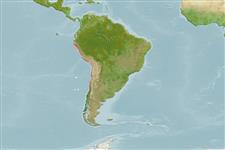Common names from other countries
Environment: milieu / climate zone / depth range / distribution range
Ecologia
marinhas demersal. Tropical; 5°S - 37°S, 82°W - 70°W
Southeast Pacific: reported from the warm temperate waters of the west coast of South America; from Callao, Peru (12° 02'S) to Talcahuano, Chile (36°41'S).
Tamanho / Peso / Idade
Maturity: Lm ? range ? - ? cm
Max length : 43.7 cm TL macho/indeterminado; (Ref. 95867); peso máx. publicado: 862.00 g (Ref. 53696)
Espinhos dorsais (total): 16 - 17; Raios dorsais (total): 18-21; Espinhos anais 3; Raios anais : 6 - 9; Vértebras: 34 - 35
This species is most abundant littoral species on the coast of central Chile, found in close association with the brown kelp Lessonia trabeculata. Juveniles found in tidepools to a maximum size of 15.7 cm TL and an estimated 3 years of age, adults occur subtidally. It is mainly herbivorous, feeding almost exclusively on brown, red and green algae, with a strong preference for green and red algae (digestion by acid hydrolysis). Its meat reported as an excellent pan-fish, with rich, white, sweet, and flaky meat (Ref. 86913).
Ciclo de vida ou comportamento de acasalamento
Maturidade | Reprodução | Desova | Ovos | Fecundidade | Larvas
Russell, B.C., 2000. Review of the southern temperate fish family Aplodactylidae (Pisces: Perciformes). J. Nat. Hist. 34(1):2157-2171. (Ref. 86913)
Status na Lista Vermelha da UICN (Ref. 130435)
CITES (Ref. 128078)
Not Evaluated
Ameaça para os humanos
Harmless
Uso pelos humanos
Pescarias: sem interesse
Mais informação
ReferênciasAquaculturaPerfil para aquaculturaEstirpesGenéticaElectrophoresesHereditariedadeDoençasProcessamentoConversão de massa
ColaboradoresFotosStamps, Coins Misc.SonsCiguateraVelocidadeTipo de nataçãoÁrea branquialOtólitosCérebrosVisão
Ferramentas
Relatórios especiais
Baixar XML
Fontes da internet
Estimates based on models
Preferred temperature (Ref.
115969): 12.8 - 23.7, mean 19.5 (based on 165 cells).
Índice de diversidade filogenética (Ref.
82804): PD
50 = 0.5625 [Uniqueness, from 0.5 = low to 2.0 = high].
Bayesian length-weight: a=0.00603 (0.00287 - 0.01263), b=3.14 (2.94 - 3.34), in cm Total Length, based on LWR estimates for this species & (Sub)family-body (Ref.
93245).
Nível Trófico (Ref.
69278): 2.0 ±0.0 se; based on diet studies.
Fishing Vulnerability (Ref.
59153): Low to moderate vulnerability (34 of 100).
